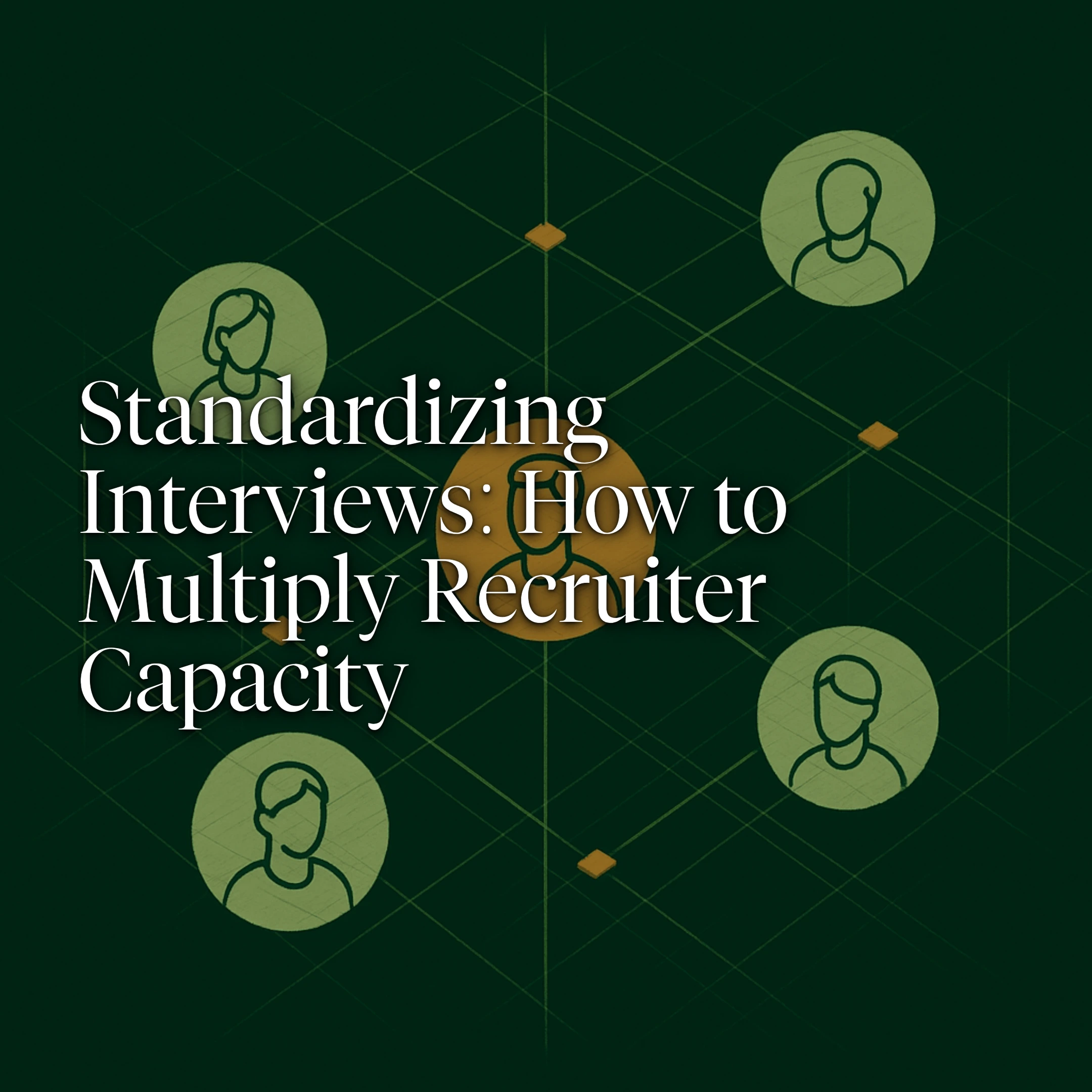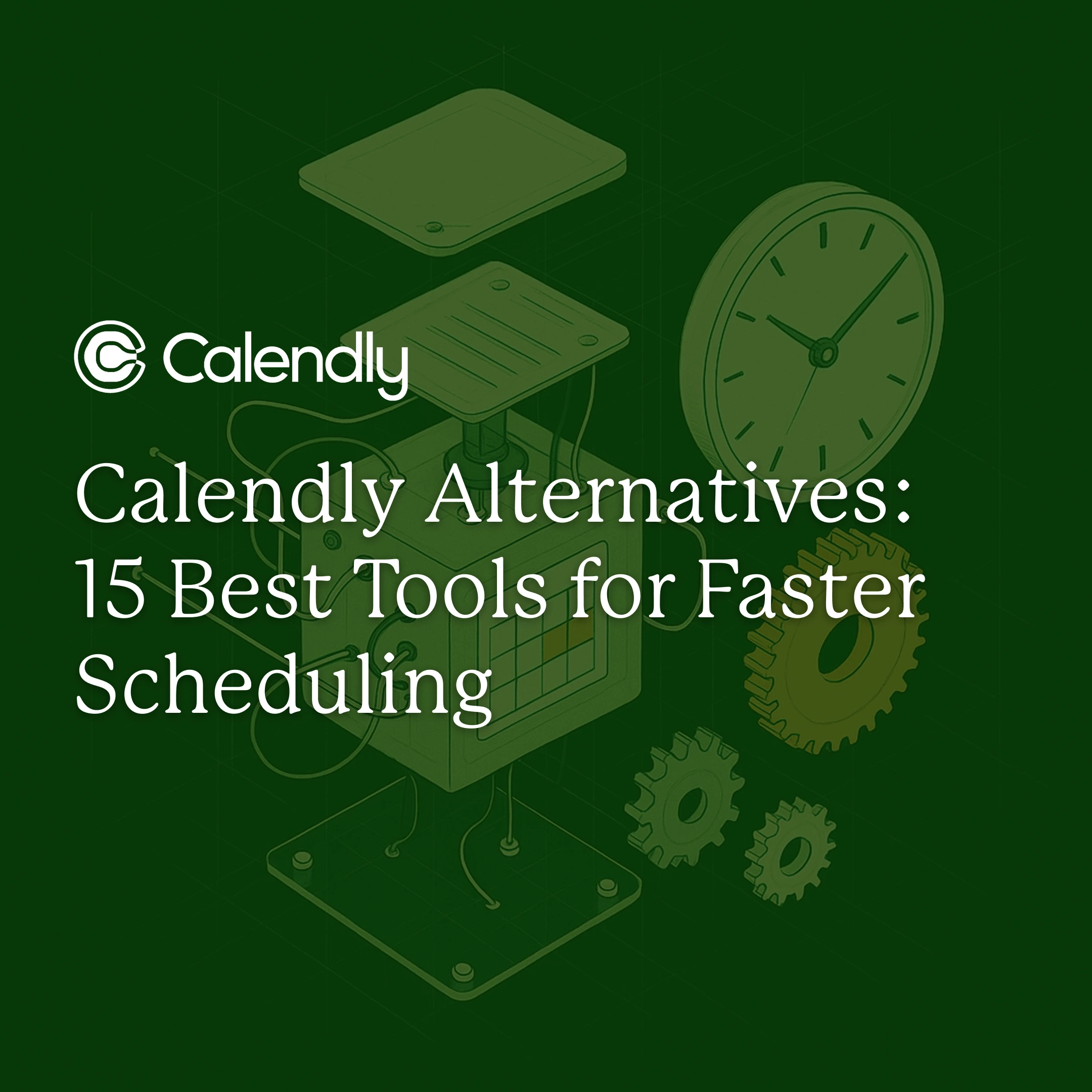How to Reduce Recruitment Admin with 12 Automation Workflows

Your recruiters spend 75% of their week on admin work instead of hiring. Resume screening, interview scheduling, and ATS updates eat up hours that should go toward candidate conversations and hiring manager partnerships.
Automation eliminates the busywork. AI-powered screening cuts resume review time from hours to minutes. Automated interview scheduling eliminates calendar ping-pong. Automated workflows handle follow-ups and status updates without manual intervention.
Here are 12 use cases for automation workflows that eliminate recruitment admin tasks to reclaim your team’s time and speed up hiring. Each one targets a specific bottleneck where manual work slows your pipeline.
Workflow 1: Job Posting and Multi-Channel Distribution
Manually posting the same vacancy to multiple job boards can consume hours each week. AI-driven templates now pull the role summary, employee value proposition (EVP), and must-have skills directly from your requisition to generate an inclusive job listing optimized for search in seconds.
Your template should include:
- A clear mission hook
- Top 3 to 5 responsibilities
- Required vs. nice-to-have skills
- Salary range
Avoid over-templating by tailoring the mission hook and key responsibilities to each specific role. Quality candidates often skip generic postings that could describe any job at any company.
Advanced workflow tools eliminate repetitive work by pushing the ad to all selected channels while simultaneously updating your ATS. Use this data to prioritize the channels that have historically delivered your most qualified applicants. Just be mindful of early sync errors, which are usually resolved by re-authenticating the job board API.
Workflow 2: Resume Screening
Recruiters often spend six or more hours daily just sifting through stacks of resumes instead of interviewing qualified candidates. AI-powered screening eliminates this bottleneck by reducing initial review time and helping you identify quality hires before competitors complete their first manual screen.
These systems parse incoming resumes, convert unstructured text into structured candidate data, and match skills, experience, and achievements against your job requirements. Contextual algorithms then instantly rank candidates and surface the top 5 to 10 profiles worth your attention instead of forcing you to manually review hundreds.
Here’s how to get started. First, define your “must-have” criteria. Feed your historical hiring decisions to your AI recruiting partner to train its weighting models. Most platforms improve accuracy as you accept or reject their recommendations. Pilot the workflow on one high-volume role, then compare screen-to-interview ratios before expanding.
Track ratios alongside shortlisted candidate quality and time-per-screen. When results drift, adjust scoring weights instead of reverting to manual review. To reduce bias, many tools anonymize names and universities. This ensures decisions are based on capability rather than pedigree.
Workflow 3: Candidate Filtering with Knockout Questions
Knockout questions instantly filter candidates who don't meet non-negotiables. Then your recruiting platform can surface qualified applicants in seconds and automatically send branded rejections to hard “no” responses.
Examples include:
- “Do you hold an active state nursing license?”
- “Are you within 30 miles of Denver?”
- “Can you start at or below $95,000?”
- “Are you available for weekend shifts?”
Your ATS handles the rest automatically. Hard “no” responses trigger branded rejection emails and borderline answers flow into nurture pools for future roles. No manual sorting required. Meanwhile, qualified applicants surface in seconds, delivering the admin-time savings that leading recruitment platforms report.
Keep it concise. Three to five knockout questions work best. Place them after basic contact details but before document uploads so applicants are invested. Track application completion rate and post-knockout candidate quality. This ensures your filters accelerate hiring without shrinking your talent pool.
Workflow 4: Rejection and Deferral Messages
Manual follow-ups on rejected or deferred candidates waste hours and create inconsistent experiences.
But rules-based messaging automates this. When you update a candidate’s status in your ATS, the right branded email goes out immediately. Every applicant gets to know where they stand, your employer brand stays protected, and your team reclaims lost time spent on manual communication.
Start by creating two core templates for each job family: one for definitive rejection and one for nurture.
Here’s a template for a rejection message:
Subject: Update on Your Application to {Role}
Hi {FirstName},
Thank you for the time you spent with us. We've moved forward with another candidate, but we were impressed by your background and will keep you in mind for future roles.
Wishing you success,
{RecruiterName}
Once your templates are ready, set up your ATS to insert candidate details automatically, configure triggers (e.g., status = “Rejected”), and test before going live. Recruiters will immediately reclaim hours previously lost to manual follow-ups, while candidates receive timely, professional updates.
Track metrics like candidate NPS (Net Promoter Score) and social reviews to quantify both improved experience and administrative time saved.
Workflow 5: Automatic Interviews
AI interview partners conduct complete screening interviews autonomously, up to thousands of interviews daily compared to the 16 maximum a human recruiter can complete. These systems ask follow-up questions based on candidate responses, assess technical skills your generalist recruiters can't evaluate, and generate decision-ready reports in 1-2 minutes instead of the 5-35 minutes required for manual review.
Let’s use Alex as an example of how this works. When a candidate applies or passes knockout filters, Alex triggers an interview invitation. It then conducts a two-way conversation to ask role-specific questions and follow up on incomplete answers, all while adapting to candidate responses in real time. 92% of candidates give the interview experience 5 stars, citing that they prefer conversational AI to traditional phone screens.
Unlike one-way video tools that candidates can easily game with prepared responses, AI interview partners like Alex detect fraud through eye tracking, voice analysis, and behavioral patterns. They conduct interviews in multiple languages and can even ask about technical skills like Python programming or system design that generalist recruiters might not feel confident evaluating.
Implementation requires three steps:
- Define your interview structure and evaluation criteria
- Calibrate the AI by reviewing sample interviews
- Integrate with your ATS to trigger interviews automatically
Since 48% of AI interviews complete outside business hours, candidates advance overnight while your team focuses daytime hours on relationship building and hiring decisions. Recruiters reclaim 6+ hours daily previously spent on screening calls.
Workflow 6: Interview Scheduling
Automated or self-serve interview scheduling eliminates calendar ping-pong by letting candidates book, reschedule, and confirm slots automatically. This workflow will save recruiters hours weekly while shortening time-to-hire. Plus, platforms that sync with Google or Outlook and apply buffer rules reduce no-shows and free up calendars instantly without any manual coordination.
Connect the scheduler to your ATS and calendars, define guardrails like interview length and availability, and run a one-week pilot with a single role to track bookings and reschedules before full rollout.
Keep human oversight for panels or executive interviews, and train hiring managers to make sure their calendars are up to date. With these controls, recruiters reclaim deep-work hours, candidates book anytime, and hiring moves faster than competitors waiting on email.
Workflow 7: Interview and Feedback Reminders
Recruiters often waste hours chasing interview confirmations and collecting feedback. Meanwhile strong candidates slip into faster-moving processes. But automated reminders remove this administrative burden.
Set up two streams in your ATS. In the pre-interview stream, calendar invite fires immediately when a slot is booked, a checklist arrives 24 hours before with webcam and other interview requirements, plus 30 minutes prior via a text message.
In the post-interview stream, a scorecard link is sent two hours after the call, with escalation to the hiring manager if feedback isn’t submitted within 48 hours.
Use personalization tokens, like {candidate_first_name}, {interviewer_name}, so messages feel human. Route through the right channels:
- Email for candidates
- Slack for engineers
- SMS for executives
Automated reminders cut no-show rates and greatly improve feedback completion. AI platforms can handle thousands of interviews daily, far beyond human capacity. This allows your team to focus on actually evaluating talent instead of sending follow-up emails.
Here are two sample messages for quick implementation.
Pre-interview (candidate): “Hi {first_name}, your chat with {interviewer_name} starts tomorrow at 10:00 AM EST. Join via the link below and plan for 45 minutes.”
Post-interview (interviewer): “Quick pulse check: rate {candidate_first_name} on the scorecard before 4 PM to keep momentum. Thanks for helping us hire faster.”
With automatic reminders, recruiters reclaim hours weekly that were spent tracking down confirmations and chasing scorecards. This workflow keeps interviews on schedule and feedback flowing without manual follow-up, so strong candidates don't slip to competitors while your team waits on responses.
Workflow 8: Interview Context Distribution
Interviewers often skim resumes at the last minute, so they’ll miss key gaps or standout achievements. Automated context packs solve this by bundling the candidate resume, application answers, scorecard template, prior notes, and scheduling details, delivered as soon as an interview is booked.
When your ATS confirms a slot, a trigger pulls live candidate data, assembles it with real-time metrics, and sends a mobile-friendly PDF or Slack message to the interviewer’s calendar invite. Since the data comes directly from your ATS and analytics tools, you don’t need manual copy-paste.
Standardize the template so every interviewer sees information in the same order. Test it on mobile. Many managers review their notes outside business hours. Faster, consistent delivery improves interview quality and candidate experience while keeping follow-up swift.
Workflow 9: Interview Analysis and Candidate Insights
Even strong interviews produce inconsistent takeaways when insights are recorded manually. Conversational analytics converts recorded interviews into structured data using natural language processing (NLP) and pattern recognition.
You get live transcripts, automatic competency scores, and keyword highlights aligned to your evaluation rubric. Hiring managers can then compare candidates objectively rather than relying on gut feelings.
The setup is simple:
- Define key competencies: This ensures the platform evaluates what actually matters for success in the role.
- Upload a few calibrated interviews as examples: Training the AI with your past hiring decisions improves scoring accuracy over time.
- Set scoring thresholds for “hire,” “hold,” or “pass”: Clear thresholds automate candidate progression without manual review of every interview.
The platform scores new candidates automatically and syncs results back to your ATS.
Standardized, criteria-based evaluations speed decisions, reduce unconscious bias, and ensure consistent hiring practices. With the right AI recruiting partner, candidate review meetings that once took an hour can now finish in fifteen minutes, so recruiters are free to focus on relationship building and candidate engagement.
Workflow 10: Onboarding Communications
Recruiters shouldn’t spend hours sending welcome emails, document requests, or e-signature links. Between offer acceptance and day one, candidates need consistent guidance, and automation handles it without manual intervention.
Onboarding sequences trigger communications directly from your ATS when a candidate accepts an offer. Welcome emails, forms, training resources, and first-day prep materials are sent automatically to allow new hires to complete tasks through a self-serve portal while your team focuses on other openings. Advanced platforms sync directly with HRIS or ATS systems, so each status change fires the next message in sequence.
The implementation is simple. Create short, branded templates for key milestones, map trigger points and test each branch with a sample hire before going live. Teams report higher candidate experience scores and faster start dates.
A typical sequence includes:
- Day -1: First day logistics
- Day 0: Welcome and next steps
- Day 1: Forms and e-signature links
- Day 5: IT and benefits checklist
When the expectations are clear from the beginning, candidates can arrive fully prepared, and recruiters can reclaim hours previously lost to admin.
Workflow 11: Real-Time Dashboards and Reporting
Recruiting leaders often spend hours each week pulling data from multiple systems and filling out reports that are outdated before they arrive. Real-time dashboards solve this by consolidating live data from your ATS, job boards, and assessment tools into a single view that updates continuously.
This immediate visibility exposes bottlenecks and opportunities. Time-to-hire creeping above target triggers alerts. A high-performing source is flagged instantly so you can double down that same day instead of discovering it during month-end reviews. Teams report decision cycles cut in half because they act on real-time insights instead of retroactive spreadsheets.
Modern dashboards provide live activity feeds, color-coded pipeline health, and automated alerts when metrics drift outside set thresholds. This reduces hours spent exporting CSVs and patching formulas, leaving recruiters free for candidate engagement. Focus on core KPIs like:
- Time-to-hire
- Stage conversion rates
- Source effectivenessCost-per-quality-hire’
- DEI ratios
Review weekly trends and daily spikes to spot issues early. Implementation starts with defining these KPIs alongside hiring managers, then designing dashboards with role-based access. The ROI is tangible. Teams using AI-powered dashboards also see higher offer-acceptance rates by addressing problems before candidates slip away to competitors still relying on manual reporting.
Workflow 12: System Integrations
When your ATS, HRIS, and communication apps don’t talk to each other, recruiters re-enter candidate data multiple times, which introduces errors at every step. API and webhook integrations create a single source of truth and eliminate repetitive clerical work, so your team can focus on higher-value activities like candidate conversations and hiring manager partnerships.
Begin by mapping every hand-off from “new applicant” to “day-one employee.” This blueprint highlights where data is duplicated, delayed, or lost. Assess each platform’s API capabilities and tackle the easiest integration wins first. A unified API layer simplifies workflow management and reduces manual errors.
Key connections include ATS-to-HRIS transfers that automatically push candidate profiles, compensation data, and compliance documents to your HRIS. Bidirectional ATS and calendar/chat syncs trigger interview invites, reminders, and status updates in Outlook, Google Calendar, Slack, or Teams. HRIS-to-payroll and IT integrations initiate equipment requests and first-paycheck setup the moment an offer is accepted.
Before going live, field-map every data point, set sync frequencies, and configure failure alerts. Sandbox testing with a small requisition catches edge-case errors before impacting production.
Teams implementing these integrations eliminate hours of duplicate data entry per hire while reducing manual errors. Prioritize high-volume, high-risk workflows first then expand to lower-volume connections to maximize efficiency gains.
Eliminate Recruitment Admin with Alex
Alex transforms how recruiting teams operate by taking over time-consuming tasks like screening, interviewing, and candidate follow-ups. It autonomously conducts interviews, scores responses against calibrated benchmarks, detects potential fraud, and advances qualified candidates so your pipeline moves continuously.
Beyond automation, Alex provides structured insights from every interaction to help recruiters make faster, more objective decisions without sacrificing candidate experience. Native integrations with platforms like Workday, Bullhorn, Greenhouse, and Lever provide bi-directional data sync to keep candidate information accurate and actionable without manual updates.
Book a demo today to see how Alex automates screening, interviews, and follow-ups so your recruiters can focus on hiring instead of admin work.
Our last posts
The latest news, interviews, and resources.
Stay ahead of the crowd
Subscribe to our official company blog to get notified of exciting features, new products, and other recruiting news ahead of everyone else.

.webp)












.avif)